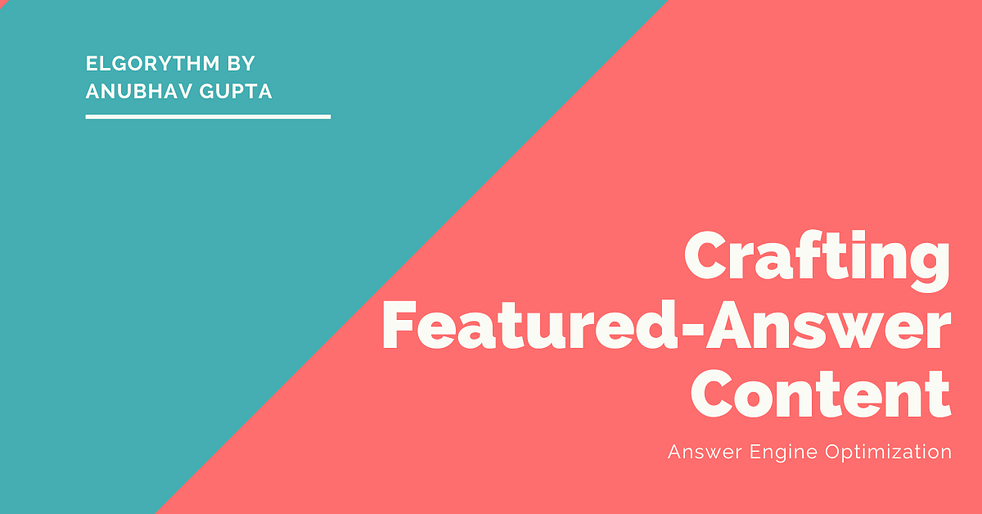Introduction: Unlocking the Full Potential of Keyword Magic
The SEMrush Keyword Magic Tool (KMT) stands as a foundational pillar in any robust digital marketing strategy. It offers unparalleled access to an expansive database, reportedly containing over 26.6 billion keywords, serving as a comprehensive resource for in-depth keyword research.1 Beyond mere keyword generation, KMT is meticulously designed to provide data-driven insights, empowering marketers to identify high-value keywords, refine content strategies, and significantly enhance website visibility and organic growth.2 This tool delivers profound understanding of s1. earch engine behavior, revealing opportunities that might otherwise remain undiscovered through more rudimentary methods.4
The contemporary digital marketing landscape is in a state of continuous evolution, largely propelled by advancements in Artificial Intelligence (AI) and Natural Language Processing (NLP). Search engines now employ sophisticated NLP techniques to decipher user intent with remarkable precision.5 This algorithmic sophistication necessitates a strategic pivot away from basic keyword identification towards more advanced methodologies. Traditional Search Engine Optimization (SEO), which historically emphasized keyword density and backlink profiles, is progressively transitioning towards Answer Engine Optimization (AEO). AEO prioritizes the delivery of precise, direct answers to user queries, particularly for prominent search features such as featured snippets, AI summaries, and voice search results.8
This guide is crafted to equip seasoned digital marketing professionals and SEO specialists with advanced strategies for leveraging the Keyword Magic Tool. It will delve into the integration of NLP principles within content workflows and demonstrate how to optimize content effectively for both conventional SEO visibility and the burgeoning AEO paradigm. The ultimate objective is to drive superior organic traffic, achieve elevated search rankings, and secure a decisive competitive advantage in the digital sphere.
The evolving role of keyword research demonstrates a clear shift from a primary focus on search volume to a more nuanced, intent-centric approach. Initially, keyword research predominantly centered on metrics like search volume and keyword difficulty.3 However, with the ascendance of NLP and AEO, the emphasis has profoundly shifted towards comprehending the underlying motivations behind user searches—their true search intent—and subsequently providing direct, authoritative answers. KMT’s capability to filter by intent 2 and pinpoint question-based queries 1 directly supports this transformation. This implies that content creators must now prioritize the quality and relevance of their answers over simply populating content with keywords, as search engines are becoming increasingly adept at discerning genuine value and contextual understanding.
Furthermore, the Keyword Magic Tool is emerging as a strategic hub rather than merely a research utility. It is explicitly positioned as an integral component of a broader SEO toolkit 1 and seamlessly integrates with other SEMrush features, including Keyword Manager, Organic Research, Keyword Gap, and Position Tracking.10 Moreover, its connectivity extends to external platforms such as Google Analytics, Google Search Console, and various content writing tools.11 This interconnectedness indicates that KMT functions as a central data repository, facilitating a holistic approach to SEO strategy—from initial research and content ideation to creation and ongoing performance monitoring. The implication is that users should interpret KMT’s output not in isolation, but as vital inputs for a cohesive ecosystem of digital optimization.
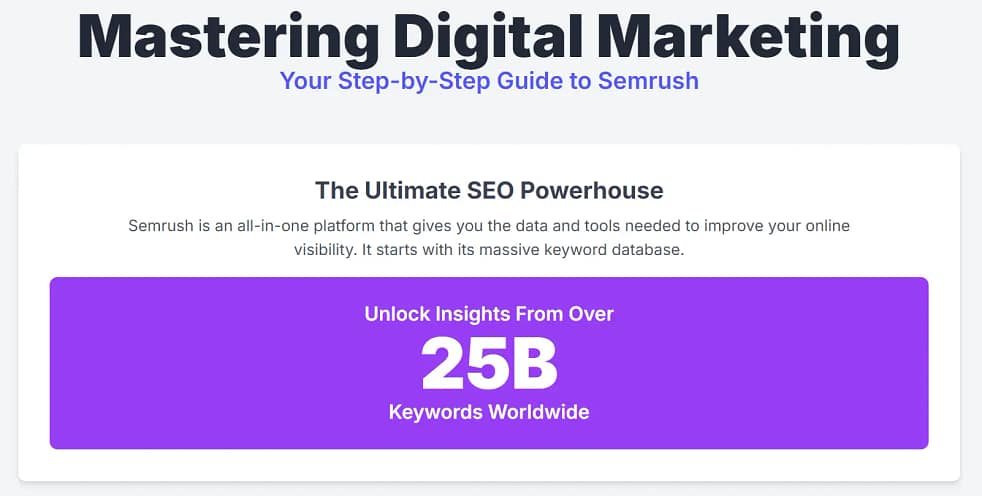
Beyond the Basics: Advanced Keyword Magic Tool Techniques
Precision Filtering for Niche & Long-Tail Opportunities
The Keyword Magic Tool offers robust filtering capabilities that extend far beyond basic keyword searches, enabling marketers to uncover highly specific and often overlooked opportunities. These advanced filters are instrumental in refining extensive keyword lists.2
One powerful application involves Match Modifiers, which allow for highly precise targeting. These modifiers include “Containing” (for an exact phrase), “Word matching” (for all words in any order), “Exactly matching” (for a single, precise keyword), “Begins with,” and “Ends with”.12 Such granular control over keyword variations is crucial for pinpointing specific user queries and tailoring content accordingly.4
Beyond linguistic matching, KMT allows for sophisticated Metric-based Filters. Marketers can filter by Keyword Difficulty (KD%) to identify low-competition phrases, often by setting a range like 0-49%.13 This strategy is particularly effective for entering niche markets where competition is less intense. Additional metric filters include search volume, Cost Per Click (CPC), and competitive density, all of which aid in identifying high-value, yet potentially easier-to-rank-for, long-tail keywords.2 The ability to filter by
Word Count specifically targets longer, more specific phrases, which typically possess lower competition and higher conversion potential.4
Furthermore, KMT allows filtering by specific SERP Features, such as Instant Answers, Product Carousels, Reviews, Featured Snippets, and “Ads top”.1 This enables marketers to target high-visibility placements directly, optimizing content for the exact format that search engines prefer for certain query types.
When employing KMT for niche market identification, a strategic approach involves starting with a broad market keyword (e.g., “baked goods”). Subsequently, applying KD% filters (e.g., 0-49%) and refining with category filters (e.g., “recipe”) can narrow down results to highly specific, less competitive niche terms, such as “gluten-free baked goods” or “baked breakfast recipes”.13 KMT is specifically highlighted as “amazing for exploring niche topics” and “finding semantically related long-tail keywords”.1
The strategic imperative of granular filtering for competitive advantage becomes evident when considering the sheer volume of keywords available in KMT, which can be overwhelming.1 While basic users might focus solely on high-volume terms, the advanced filtering options 4 enable a highly granular approach. By combining filters such as low Keyword Difficulty percentages with specific SERP features or long-tail word counts, marketers can unearth “hidden gems” 14 and “feasibly attainable keywords” 1 that competitors may overlook. This elevates keyword identification to a strategic maneuver, targeting specific, high-intent, and less competitive opportunities, thereby directly impacting return on investment by concentrating efforts where ranking is more achievable.
Moreover, KMT’s utility extends beyond traditional SEO, positioning it as a powerful market research tool. Its capacity to identify niche markets 13 and analyze intricate search patterns 1 suggests a broader application. By filtering for specific categories and examining search volume trends over time 13, businesses can validate market interest for nascent products or services, gain a deeper understanding of evolving consumer needs, and even inform product development cycles. This transforms KMT from a purely technical SEO utility into an invaluable resource for market intelligence.
Table 1: Advanced Keyword Magic Tool Filters & Their Applications
Filter Type | Description | Strategic Application |
Match Modifiers |
|
|
Containing | Keywords must contain the exact phrase. | Targeting specific, precise phrases for direct relevance. |
Word matching | Keywords must contain all words, order flexible. | Capturing variations where word order might differ. |
Exactly matching | Only one keyword, exact phrase match. | Pinpointing highly specific, singular target queries. |
Begins with | Keywords must start with the specified phrase. | Identifying early-stage user queries or brand searches. |
Ends with | Keywords must end with the specified phrase. | Discovering specific long-tail completions or question endings. |
Metric-Based Filters |
|
|
Keyword Difficulty (KD%) | Assesses ranking challenge (0-100%). | Prioritizing low-competition keywords (e.g., 0-49%) for quicker wins or niche entry. |
Search Volume | Average monthly searches. | Balancing high potential with achievable ranking difficulty. |
CPC | Average Cost Per Click for advertising. | Informing PPC strategy and identifying high-value commercial intent. |
Competitive Density | Level of advertiser competition. | Assessing paid search competition for a keyword. |
Word Count | Number of words in the keyword phrase. | Focusing on long-tail keywords (e.g., 4+ words) for higher specificity and lower competition. |
SERP Features |
|
|
Featured Snippets | Content appearing directly in SERP. | Optimizing for “position zero” and direct answers. |
Instant Answers | Concise definitions/facts. | Targeting quick, factual answers for AEO. |
Product Carousels | E-commerce product listings. | Identifying commercial intent and product-focused queries. |
Reviews | Star ratings, review snippets. | Understanding user intent for product/service evaluation. |
Ads Top | Keywords triggering top paid ads. | Analyzing competitor ad strategies and high commercial intent. |
Uncovering Semantic Goldmines & Topic Clusters
The Keyword Magic Tool is exceptionally effective for delving into niche topics and unearthing semantically related long-tail keywords.1 This capability extends to identifying “secondary keywords,” which are supporting terms designed to broaden content relevance (e.g., “tips for eating healthy” as a secondary keyword for “how to eat healthy”).2 Equally important are “semantic keywords,” which, while not necessarily direct ranking targets, help search engines grasp the broader context of content (e.g., “whole foods,” “meal prep,” and “balanced nutrition” for an article on “how to eat healthy”).2 The integration of these related keywords, including semantic ones, is crucial for establishing topical relevance and enhancing search engines’ comprehension of content, potentially leading to improved rankings across a wider array of keywords and an increase in visits and conversions.2
A significant feature of KMT is its ability to automatically group target keywords into topic-specific subgroups.1 This automatic clustering, combined with the dedicated “Questions” filter 1, is invaluable for generating novel content ideas and constructing comprehensive topic clusters around core themes.4 This approach aligns with how NLP functions within search engines, as NLP helps these systems understand the context and relationships between words.5 KMT’s grouping and semantic keyword suggestions directly facilitate this process by providing terms that enhance topical relevance, even if they are not explicitly targeted for direct ranking.2
The ability of KMT to identify and organize semantically related terms and topic clusters facilitates a profound shift from optimizing for individual keywords to building comprehensive topical authority. This approach is increasingly favored by search engines powered by advanced NLP. KMT’s automatic grouping of keywords into topic-specific subgroups 1 and its capacity to find semantically related long-tail keywords 1 directly support this paradigm. NLP, in turn, helps search engines understand the context, relationships, and intrinsic meaning of text 18, allowing them to focus on the main topics or subjects within content.5 By providing tools to identify and organize these semantically related terms and topic clusters, KMT empowers marketers to create content that thoroughly covers a subject. This depth signals topical authority to search engines, which, through their NLP capabilities, can then better understand the content’s relevance to a broader spectrum of user queries. The result is often higher rankings and increased organic traffic for a more extensive set of terms, representing a proactive strategy to align with Google’s evolving understanding of expertise and content quality.

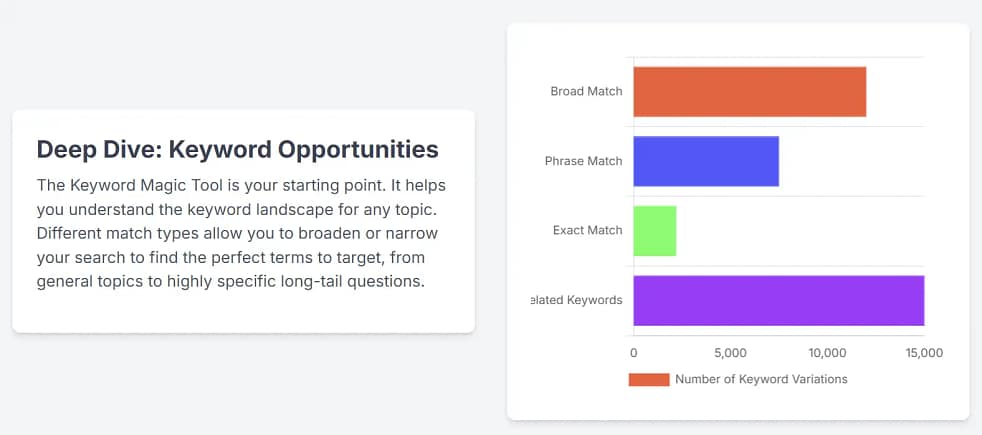
Competitor Intelligence with the Keyword Magic Tool
The Keyword Magic Tool, when utilized in conjunction with other SEMrush functionalities such as Domain Overview and Keyword Gap, serves as a powerful instrument for competitive analysis. This synergy enables marketers to identify significant “keyword gaps”—instances where competitors are ranking for valuable keywords that a user’s site currently is not.3 Such analysis often uncovers opportunities characterized by high search volume or relatively low keyword difficulty, presenting fertile ground for targeted optimization efforts.3
Beyond merely identifying gaps, KMT facilitates in-depth analysis of competitor strategies. By inputting a competitor’s domain into SEMrush, marketers can comprehensively uncover the keywords they are ranking for.14 This provides critical intelligence regarding the tactics employed by others in the market.3 Such insights are invaluable for identifying weaknesses in one’s own keyword strategy and pinpointing avenues to outperform rivals in Search Engine Results Pages (SERPs).14
This sophisticated competitive analysis capability allows marketers to transcend reactive SEO tactics and engage in proactive market positioning. It moves beyond the singular pursuit of one’s own keywords to encompass an understanding of the entire market’s keyword landscape, including areas of competitor strength and existing opportunities. This leads to more efficient resource allocation and the potential to establish a more defensible market position, shifting the strategic focus from isolated keyword battles to a broader competitive framework.
Leveraging KMT for AEO & Voice Search Readiness
The Keyword Magic Tool plays a pivotal role in bridging traditional keyword research with the demands of Answer Engine Optimization (AEO) and voice search. This is particularly evident in its ability to facilitate the targeting of question-based queries and content with informational intent. KMT’s dedicated “Questions” filter is an invaluable feature for identifying common questions related to a given topic.1 These question-based queries typically carry informational intent and are prime candidates for capturing high-visibility search features such as featured snippets, AI Overviews, and People Also Ask (PAA) sections.6
Furthermore, KMT aids in identifying opportunities for featured snippets by allowing users to filter for specific SERP features, including “Ads top” or general “Featured snippet” opportunities.4 This capability helps pinpoint keywords that are highly likely to trigger these direct answers, enabling marketers to tailor their content for immediate visibility in the search results.
KMT acts as a critical bridge between conventional keyword research and the evolving requirements of Answer Engine Optimization, facilitating direct optimization for AI-driven search results. The tool’s “Questions-only filter” 1 and its capacity to identify question-based queries that can significantly enhance visibility in featured snippets, AI Overviews, and PAA sections 6 underscore its adaptability. AEO itself is fundamentally centered on providing precise answers to user queries and improving visibility in featured snippets, AI summaries, and voice search results.8 This demonstrates KMT’s responsiveness to the evolving search landscape, as it helps marketers proactively structure content for the formats preferred by AI and voice assistants, ensuring content is “answer-ready” for the modern search environment.
Integrating NLP for Deeper Keyword Insights & Content Creation
Understanding User Intent with NLP
Natural Language Processing (NLP) is fundamental to how modern search engines operate, enabling them to comprehend human language, analyze context, and identify intricate relationships within text.5 This advanced understanding allows search engines to decipher the underlying purpose behind a user’s search query, commonly referred to as user intent.5
There are typically four main categories of search intent:
- Informational: Users seeking knowledge or answers (e.g., “how to adopt a dog”).6
- Navigational: Users looking for a specific website or webpage (e.g., “Spotify login”).6
- Commercial: Users researching options before making a purchase (e.g., “best office chairs under $250”).6
- Transactional: Users ready to make a purchase or perform an action (e.g., “buy yoga mat online”).6
SEMrush’s Keyword Magic Tool, with its intent filter, and the Keyword Overview tool, are instrumental in analyzing search intent for any target keyword.2 By examining the SERP analysis section within SEMrush, marketers can gain a deeper understanding of the content types and formats that currently rank for specific queries, further informing content strategy.6
NLP serves as the core engine behind intelligent search. A comprehensive understanding of how search engines leverage NLP to interpret user intent—moving beyond mere keyword matching—is critical for crafting truly relevant and effective content. This shifts the focus from simply identifying “what keywords are searched” to discerning “what problem the user is attempting to solve,” ultimately leading to higher quality content and enhanced user satisfaction.
Crafting Content for AI-Driven Search
The proliferation of AI in search, particularly with the rise of AEO and AI Overviews, necessitates a dual approach to content creation: content must be designed for both human readability and machine interpretability. This is where NLP principles become indispensable.
Content should be written in a natural language and conversational tone, mirroring how people speak in everyday conversations and voice queries.19 This is particularly vital for voice search optimization, where queries tend to be longer, more specific, and conversational in nature (e.g., “Where can I find the best pizza near me?” instead of “best pizza near me”).20
For AEO, the importance of providing clear, concise, and direct answers cannot be overstated. Content should aim to answer questions briefly before delving into greater detail, increasing the likelihood of appearing in featured snippets and AI Overviews.8 Voice search responses, for instance, are often concise, typically 30 words or fewer.8
NLP-powered AI tools are increasingly facilitating various aspects of content creation. These tools can automate content analysis, suggest optimizations, and even generate initial drafts, streamlining the process while ensuring precision and alignment with user intent.24 This integration enables content personalization by analyzing user interactions and preferences, leading to increased engagement and reduced bounce rates.24
The rise of AI in search means that content must be meticulously engineered for both human comprehension and algorithmic processing. NLP principles guide this process, ensuring that content is not only rich in relevant keywords but also semantically coherent and directly addresses user queries, making it inherently “snippet-ready” and “voice-ready.”
Table 3: Key Differences: Text Search vs. Voice Search
Factor | Text Search | Voice Search |
Query Length | Typically 1-3 words | Often 7-10 words 21 |
Intent | Broadly informational, navigational, commercial, transactional | Often immediate action, question-based 21 |
Result Type | Multiple “10 blue links” | Often a single, concise answer (e.g., featured snippet) 21 |
Language Style | Keywords, abbreviated phrases | Natural, conversational language 20 |
Optimizing Your Content for SEO & AEO Success
Structuring for Featured Snippets & Direct Answers
Capturing featured snippets and direct answers is paramount for achieving “position zero” in search results, a critical objective for AEO. Strategic content structuring is key to this endeavor.
Heading Structure: Employ a hierarchical content structure using H1, H2, and H3 tags. The H1 tag should encapsulate the main keyword and overall theme of the page.26 Subsequent H2 and H3 tags should break down sections, incorporating related keywords and, importantly, question-based queries.23 Placing questions directly in subheadings (H2 or H3) and providing a clear, direct answer in the immediate paragraph (ideally 40-60 words for paragraphs, or under 30 words for voice search answers) significantly increases the likelihood of snippet capture.21
Content Formats: Google frequently pulls featured snippets from various content formats:
- Paragraphs: Best for definitions or concise answers, typically 40-60 words.23
- Lists: Both numbered (for step-by-step instructions or ranked items) and bulleted (for unordered information) are highly effective.23
- Tables: Ideal for comparative data, Google looks for HTML <table> elements with clear headers (<th>) and organized data cells (<td>). A table with 5 rows and 3 columns often works best for display limits.23
- Videos: Primarily pulled from YouTube, especially for “how-to” queries.28
Schema Markup: Implementing structured data, particularly FAQ Schema and How-To Schema, helps search engines better understand the question-answer formats and step-by-step instructions within content, increasing the chances of appearing in featured snippets.8 Local Business Schema is also crucial for local search queries and voice search, providing essential business information.21
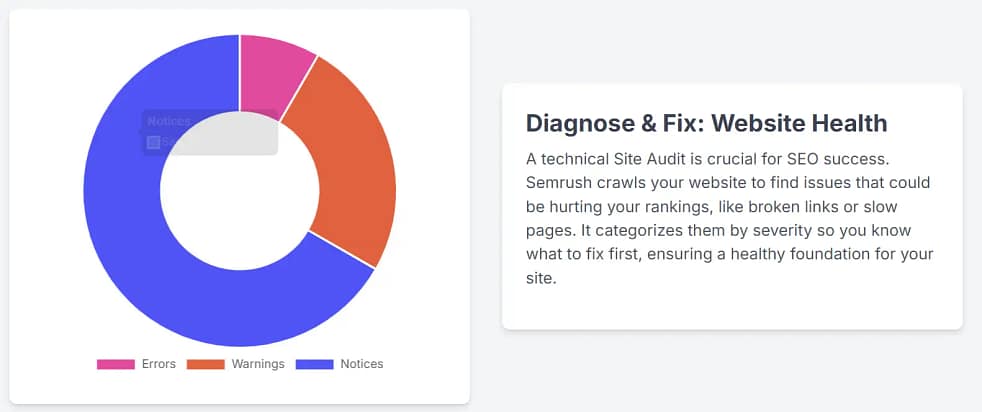
Featured snippets and direct answers represent “position zero” and are critical for AEO. This section details the practical methods for structuring content to capture these highly visible positions, directly linking content format to search visibility. It underscores the importance of engineering content for maximum algorithmic digestibility, ensuring it is readily interpretable and extractable by search engines.
Table 2: Content Formats for Featured Snippets
Snippet Type | Characteristics/Optimal Length | Optimization Tips |
Paragraph | Concise answer, definition, or description. Around 40-60 words.23 | Place direct answer immediately after H2/H3 question.23 Use neutral, objective tone.23 |
Numbered List | Step-by-step instructions, sequential processes, ranked items.23 | Use ordered HTML lists (<ol>). Ensure clear, concise steps. |
Bullet List | Unordered lists of items, features, or tips.23 | Use unordered HTML lists (<ul>). Provide clear, distinct points. |
Table | Comparative data, structured information. Optimal 5 rows, 3 columns.23 | Use HTML <table> with <th> for headers and <td> for data cells. Add <caption>.23 |
Video | Visual explanations, tutorials, demonstrations.28 | Embed on relevant page with descriptive title/description.27 Optimize for YouTube. |
List/Paragraph + Image Combo | Text snippet accompanied by a relevant image.28 | Include high-resolution, relevant images with descriptive alt text.28 |
Natural Keyword Integration & Content Quality
Modern search engine algorithms, powered by NLP, prioritize meaningful content over mere keyword repetition. Therefore, avoiding keyword stuffing is paramount, as it can compromise content quality and negatively impact search rankings.26 The focus should always be on writing well and naturally integrating keywords, rather than forcing them into sentences.19
A recommended approach is to draft content initially without excessive focus on keyword density, then revisit and optimize sentences and phrases to naturally incorporate target keywords.19 If a keyword feels forced, it likely is, and it should be rephrased or saved for a different sentence.30 Current algorithms are less concerned with specific keyword density, emphasizing instead the natural flow and relevance of the content.30
The quality of content is a critical determinant of SEO and AEO success. Content must be high-quality, unique, and up-to-date.19 It should be helpful, reliable, and people-first, directly addressing user search queries, engaging readers, and providing genuine value.8 Well-written content, characterized by correct grammar, active voice, and clear explanations, tends to rank better because it is perceived as more trustworthy and professional.19 Longer content, typically around 2,000 words, often performs well, providing ample space to thoroughly answer questions and naturally integrate various long-tail keywords.19
Google’s algorithms, driven by NLP, prioritize user value and natural language over simple keyword repetition. This means that content quality and relevance are paramount, and “natural integration” is not merely a stylistic preference but an algorithmic necessity for achieving high rankings.
Strategic Internal & External Linking
A well-executed linking strategy is fundamental for both SEO and AEO, contributing significantly to a website’s overall authority and discoverability.
Internal links connect different pages within the same website.31 They are crucial for distributing “link value” (or “link juice”) across a site, enhancing the SEO of important pages beyond just the homepage.32 Effective internal linking improves user experience by simplifying navigation, guiding visitors to relevant content, and reducing bounce rates.32 It also boosts crawlability, as search engine bots follow these links to discover and index new pages, thereby strengthening the site’s overall structure and enhancing page authority.32 Contextual links within the body of content and navigational links (menus, sidebars) are both vital components of this strategy.32
External links, conversely, point to pages on different websites.31 While they do not pass internal link value, linking to reputable, authoritative sources can enhance the credibility and trustworthiness of one’s own content, which is a key component of E-A-T (Expertise, Authoritativeness, Trustworthiness).8
The choice of anchor text—the clickable text of a hyperlink—is also critical. It should accurately describe the content of the linked page, providing clear signals to both users and search engines about the destination content.32
Linking strategy, both internal and external, is crucial for establishing topical authority and improving crawlability, which indirectly supports NLP’s understanding of content hierarchy and relationships. It is about constructing a robust, interconnected knowledge base that serves both human users and search engine algorithms effectively.
Measuring Your Magic: Tracking Performance & Adapting Strategy
The pursuit of SEO and AEO excellence is not a one-time endeavor but an iterative, continuous process. Consistent monitoring of performance metrics and a willingness to adapt strategies are essential for sustained success in the ever-evolving search landscape.
Key performance indicators to track include keyword rankings and featured snippet capture rates.3 SEMrush’s Position Tracking tool is invaluable for this, allowing marketers to monitor keyword rankings over time, identify trends in organic traffic, and pinpoint new keyword opportunities.3 Analyzing snippet capture rates provides direct feedback on the effectiveness of AEO strategies.8
Regularly reviewing and updating outdated information is also vital for maintaining content accuracy and relevance.8 Adjusting content based on user feedback and emerging search trends ensures that strategies remain aligned with current search behavior.8 Keyword research, for instance, should be conducted at least quarterly to account for seasonal shifts and changing user interests.14
The ability to track performance metrics and adapt strategies is essential for long-term success in an ever-evolving search landscape. This underscores the iterative nature of digital marketing, where continuous analysis and refinement drive sustained visibility and engagement.
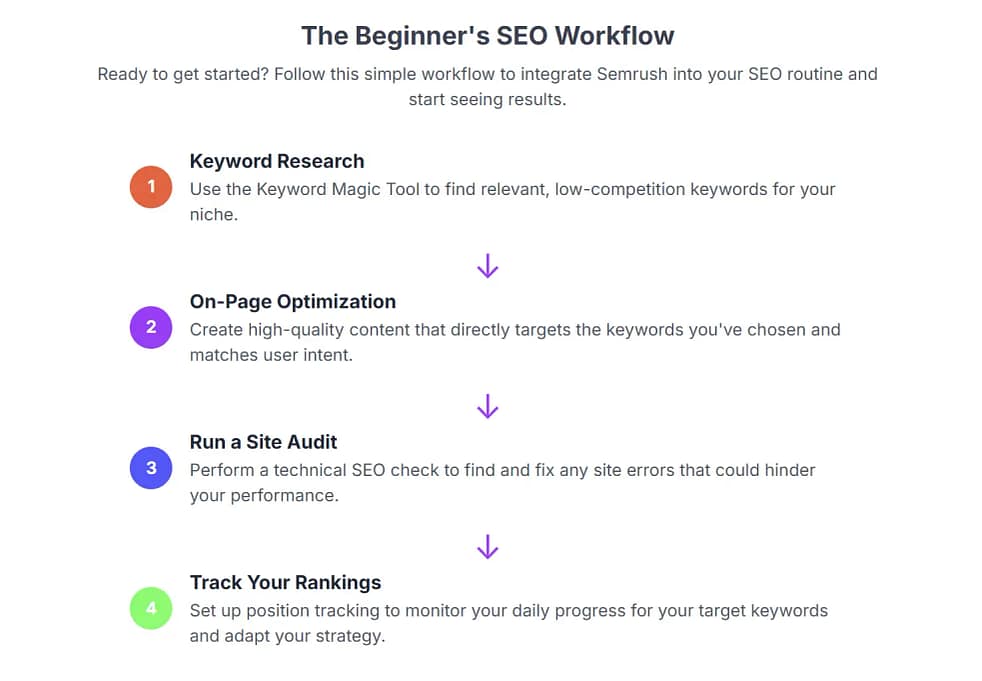
Conclusion
Mastering the Keyword Magic Tool transcends basic keyword research; it involves leveraging its advanced capabilities to navigate the intricate and evolving digital landscape. By employing precision filtering, marketers can uncover niche and long-tail opportunities, gaining a strategic competitive advantage through granular targeting. The tool’s ability to identify semantic relationships and group keywords into topic clusters facilitates a profound shift towards building topical authority, aligning content with how modern, NLP-powered search engines interpret information.
Integrating NLP principles into content strategy is no longer optional but a necessity. Understanding user intent—whether informational, navigational, commercial, or transactional—allows for the creation of content that truly resonates with audiences and satisfies their underlying needs. This intent-driven approach, combined with crafting content in natural, conversational tones and structuring it for direct answers, is critical for success in the era of AI-driven search and voice assistants.
Optimizing for both SEO and AEO requires a meticulous approach to content structure, particularly for capturing featured snippets. Implementing appropriate heading hierarchies, utilizing diverse content formats like lists and tables, and applying structured data markup are all vital steps. Furthermore, prioritizing natural keyword integration over forced density and maintaining high content quality are paramount, as search algorithms increasingly value user experience and genuine relevance. Finally, a strategic linking architecture, both internal and external, reinforces topical authority and enhances discoverability.
The journey to digital marketing mastery is continuous. By consistently leveraging the advanced functionalities of the Keyword Magic Tool, integrating NLP-informed content creation, and diligently monitoring performance metrics, digital marketers can adapt to the dynamic search environment, secure prominent visibility, and drive meaningful engagement and conversions. The future of search demands a holistic, data-driven, and user-centric approach, with KMT serving as a powerful ally in this ongoing evolution.
Works cited
- How does Keyword Magic Tool work? – Semrush, accessed on July 21, 2025, https://www.semrush.com/kb/262-keyword-magic-tool
- What Are Related Keywords? And 6 Ways to Find Them – Semrush, accessed on July 21, 2025, https://www.semrush.com/blog/related-keywords/
- SEMrush Keyword Magic Tool: How to develop an enchanted content strategy (tutorial), accessed on July 21, 2025, https://www.brafton.com/blog/strategy/semrush-keyword-magic-tool-tutorial/
- Optimizing SEO Content with NLP: A Content Strategy with NeuronWriter, accessed on July 21, 2025, https://neuronwriter.com/optimizing-seo-content-with-nlp-a-content-strategy-with-neuronwriter/
- NLP in SEO: What It Is & How to Use It to Optimize Your Content – Semrush, accessed on July 21, 2025, https://www.semrush.com/blog/nlp-seo/
- SEO and User Intent: Content Strategy For The Modern Search Journey – RivalFlow AI, accessed on July 21, 2025, https://www.rivalflow.com/blog/seo-and-user-intent-content-strategy
- How to Do AEO: 7 Essential Steps for Optimizing Your Content for AI – Gorilla Marketing, accessed on July 21, 2025, https://gorillawebtactics.com/how-to-do-aeo-in-7-easy-steps/
- AGI vs Answer Engine Optimization (AEO) | Why Both AGI and AEO are Important – YouTube, accessed on July 21, 2025, https://www.youtube.com/watch?v=pUm-fWY1sU4&vl=en
- Keyword Research Tools | Semrush, accessed on July 21, 2025, https://www.semrush.com/features/keyword-research-toolkit/
- What Integrations are available in Semrush?, accessed on July 21, 2025, https://www.semrush.com/kb/931-integrations
- How do keyword filters in Semrush work?, accessed on July 21, 2025, https://www.semrush.com/kb/728-how-do-keyword-filters-work
- What Is a Niche Market? How to Find Yours (Plus Examples), accessed on July 21, 2025, https://www.semrush.com/blog/niche-market/
- How To Do Keyword Research With Semrush For Big SEO Gains – Flying V Group, accessed on July 21, 2025, https://www.flyingvgroup.com/seotools/how-to-do-keyword-research-with-semrush/
- Free Keyword Research Tool: Find SEO Keywords in Seconds, accessed on July 21, 2025, https://www.semrush.com/analytics/keywordmagic/
- 13 Advanced SEO Techniques & Strategies for 2025 – Semrush, accessed on July 21, 2025, https://www.semrush.com/blog/advanced-seo/
- How to Use NLP in SEO to Rank Faster (9,000+ Keywords Tested) – YouTube, accessed on July 21, 2025, https://www.youtube.com/watch?v=cIuYai4vs_4
- Topic Modeling and Semantic Clustering with spaCy | by Fouad Roumieh – Medium, accessed on July 21, 2025, https://fouadroumieh.medium.com/topic-modeling-and-semantic-clustering-with-spacy-960dd4ac3c9a
- How to Use SEO Keywords Naturally – Cyberclick, accessed on July 21, 2025, https://www.cyberclick.net/numericalblogen/how-to-naturally-include-keywords-in-your-seo-content
- What role does voice search optimization play in modern SEO strategies? – Quora, accessed on July 21, 2025, https://www.quora.com/What-role-does-voice-search-optimization-play-in-modern-SEO-strategies
- Voice Search Optimization: Prepare Your Content for the Future – HumansWithAI, accessed on July 21, 2025, https://humanswith.ai/blog/voice-search-optimization-prepare-your-content-for-the-future/
- AEO: Why answer engine optimization matters to your content strategy, accessed on July 21, 2025, https://wgcontent.com/blog/aeo-answer-engine-optimization/
- How To Win Featured Snippets: A Step-by-Step Guide [2025 Edition] – Niumatrix Digital, accessed on July 21, 2025, https://niumatrix.com/search-featured-snippets-guide/
- Harnessing Natural Language Processing to Create SEO-Friendly Content with AI, accessed on July 21, 2025, https://amurpress.info/blogs/46090/?harnessing-natural-language-processing-to-create-seo-friendly-content-with-ai
- Natural Language AI – Google Cloud, accessed on July 21, 2025, https://cloud.google.com/natural-language
- SEO Best Practices for Meta Titles & Descriptions – team lewis, accessed on July 21, 2025, https://www.teamlewis.com/magazine/seo-metadata-best-practices-on-page-optimization/
- SEO Starter Guide: The Basics | Google Search Central | Documentation, accessed on July 21, 2025, https://developers.google.com/search/docs/fundamentals/seo-starter-guide
- Featured Snippets – AWR SEO Guide – Advanced Web Ranking, accessed on July 21, 2025, https://www.advancedwebranking.com/seo/featured-snippets
- Blog SEO: How to Search Engine Optimize Your Blog Content – HubSpot Blog, accessed on July 21, 2025, https://blog.hubspot.com/marketing/blog-search-engine-optimization
- Natural Keyword Integration – Stellar Content, accessed on July 21, 2025, https://www.stellarcontent.com/resources/writer/university/seo-keywords/natural-keyword-integration/
www.networksolutions.com, accessed on July 21, 2025, https://www.networksolutions.com/blog/internal-linking-seo-strategy-guide/#:~:text=Internal%20links%20connect%20one%20page,to%20pages%20on%20other%20websites.
- Internal Linking: What It Is and Why It Matters for SEO – Clearscope, accessed on July 21, 2025, https://www.clearscope.io/blog/what-is-internal-linking


